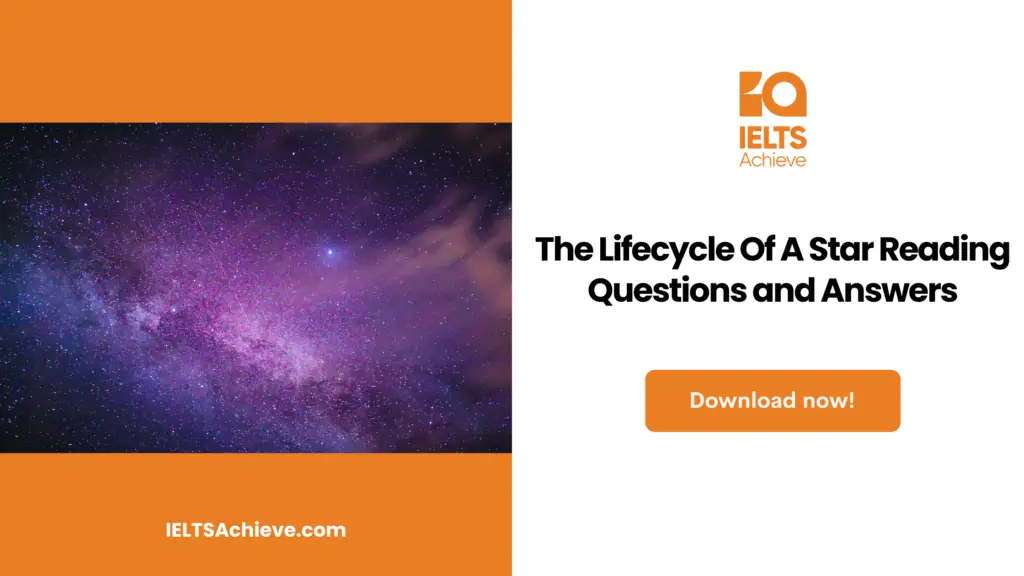The Blog post contains the following IELTS Reading Questions:
- IELTS Reading True/False/Not given
- IELTS Reading Sentence completion
- IELTS Reading Matching Features
Stay informed and prepared for success – Explore our comprehensive Reading Test Info page to get valuable insights, exam format details, and expert tips for mastering the IELTS Reading section.
IELTS the Life cycle of a star Reading Passage

The Lifecycle Of A Star
A. The number of stars in the cosmos has been estimated to be around 109 or 108. Though the actual age of a star is unknown (astronomers have discovered stars as young as 25,000 years old and others are considered to be over 10 billion years old), astronomers do know that there are many different types of stars.
B. Each star’s kind and lifespan is determined by its mass and the process by which it was produced. A nebula is a massive cloud of gas and dust where stars form. The more material that enters the nebula, the more massive the resulting star will be. There are dense gas regions inside these nebulae, and their gravitational attraction is greater than that of the surrounding space because of this. Over time, the nebula’s gas is compressed by gravity, causing it to spin and heat up.
C. At 15,000,000°C, nuclear fusion takes place at the cloud’s core, causing it to light brightly. At this temperature, it cools down enough to settle, contract slightly, and become a main-sequence star (an example of this is our own Sun). This phase can last for hundreds of thousands, or perhaps millions, of years.
D. While emitting light, the hydrogen at its core undergoes nuclear fusion, transforming it into the lighter and more stable element helium. Over time, the star’s core loses hydrogen and becomes unstable, compressing further. However, as the star’s outer regions (which are still mostly hydrogen) expand and cool, the star’s colour changes from blue to red.
E. As a result of its rapid expansion, the star is now a red giant. The Sun will need another 5 billion years to mature to this point, according to current estimates. By that time, it will have expanded to swallow up Mercury, Venus, and Earth, and will shine 2,000 times brighter than it does now.
F. How a star behaves in the red giant phase is determined by its mass. The star’s core continues to heat up as the hydrogen in its outer layers continues to burn throughout the red giant phase. When the temperature reaches 200,000,000°C, the helium atoms fuse to produce carbon. The remaining hydrogen undergoes a supernova explosion, creating a planetary nebula in a ring around the star’s centre.
G. Once the final helium atoms have fused into carbon atoms in a medium-sized star, the star begins to die. The remaining stellar matter collapses inwards under the influence of gravity, becoming exceedingly dense. White dwarf is the name for this type of star. It will radiate intense heat and light until all of its energy is used up (as thermal energy trapped within its interior). This may take a very long time, possibly even a few billion years. When a star reaches this state, it is called a black dwarf and is doomed to exist as such forever because of its extreme cold and darkness (and possibly diamonds).
H. There is enough gas and dust in the planetary nebula produced when the largest red giants (massive stars) collapse, which takes place in an instant, to be used as building material for planets in emerging solar systems. Carbon atoms are drawn together to produce heavier elements like oxygen, nitrogen, and iron in big stars as their temperatures rise. After this point, the iron atoms stop fusing and start absorbing energy instead. These stored energies are eventually unleashed in a supernova, a massive explosion in the distant future. The explosion of a supernova, with a core temperature of up to 1 billion degrees Celsius, can shine brighter than any galaxy and illuminate the sky for weeks. As far as astronomers can tell, Earth is built of stuff that originated on the inner surface of stars, namely on the inside of red giants that explode as supernovae. A million years is the typical lifespan of these enormous stars.
I. The neutron star is what’s left of a star between 1.5 and 4 times as massive as the Sun after it goes supernova. When it gets going, it spins and frequently sends out radio waves. A neutron star is called a pulsar if its radio emissions come in pulses. After becoming a supernova, a star with eight times the mass of the Sun or more will still be considered massive. Due to the lack of core nuclear fusion, it eventually collapses under its own weight and disappears. A black hole forms as a result, sucking in any nearby matter or energy. A black hole’s gravitational field is so strong and dense that it prevents light from escaping and cannot be measured. John Archibald Wheeler, a scientist, coined the term “black hole,” which replaced the older term “frozen star.” X-ray binary star Cygnus X-1 was discovered in 1971, but Wheeler came up with the moniker two years earlier in 1969. Some astrophysicists speculate that each galaxy contains a black hole.
J. This is the true nature of a star’s death and rebirth, as the remnants of an exploding star eventually become diluted in the hydrogen of the cosmos. A new star will eventually form from this brew. The Sun is an example of this; it contains material from many stellar explosions that occurred before the Sun’s birth.
Unlock your full potential in the IELTS Reading section – Visit our IELTS Reading Practice Question Answer page now!
Recommended Questions:
Renewable Energy IELTS Reading Question with Answer
The Lifecycle Of A Star Reading Questions
Questions 1-3
Do the following statements agree with the writer’s views in the Reading Passage ? Write,
- TRUE if the statement is true according to the passage
- FALSE if the statement is false according to the passage
- NOT GIVEN if the statement is not given in the passage
- It spins frequently but the radio waves are not sent out.
- Each galaxy contains a black hole.
- It has been said that astronomers are not completely aware about the life cycle of a star.
Enhance your skills in identifying information as True, False, or Not Given. Click here to discover expert strategies and techniques for mastering this question type in the IELTS Reading section.
Questions 4-7
Complete the sentences using NO MORE THAN THREE WORDS for each answer. Write for the questions 4 – 7 on your Answer Sheet.
4. After _____, hydrogen will be converted to helium.
5. The red giant’s colour develops as the __ shrinks and the outer parts cool.
6. The star’s helium atoms fuse into carbon atoms at 200,000,000°C, and the Star_____.
7. Large stars, as opposed to small and medium-sized stars, ______quickly.
Enhance your sentence completion skills in the IELTS Reading section. Click here to access our comprehensive guide and learn effective strategies for filling in missing words or phrases in sentences.
Questions 8-13
Different stages and types of stars are mentioned in the lifecycle of a star reading passage. Choose ONE of the types or stages (A–J) from the box below that best matches the descriptions.
NOTE: you may use any answer more than once.
A. Nebula
B. main-sequence star
C. red giant
D. white dwarf
E. black dwarf
F. Supernova
G. neutron star
H. black hole
Example: hottest, brightest point of a star Answer: F
8. the Sun _________
9. birthplace of a star _________
10. a dying star _________
11. sometimes has pulsating waves _________
12. its size is immeasurable _________
13. its supply of energy has run out _________
Ready to conquer Matching Headings questions? Click here to learn essential tips and techniques for matching headings accurately to paragraphs or sections in the IELTS Reading section.
Unlock your full potential in the IELTS Reading section – Visit our IELTS Reading Practice Question Answer page now!
Recommended Questions:
Renewable Energy IELTS Reading Question with Answer
The Lifecycle Of A Star Reading Answers
1. False
2. True
3. Not given
4. Nuclear fusion
5. Core
6. Stars to die
7. Collapse
8. B
9. A
10. D
11. G
12. H
13. E

We hope you found this post useful in helping you to study for the IELTS Test. If you have any questions please let us know in the comments below or on the Facebook page.
The best way to keep up to date with posts like this is to like us on Facebook, then follow us on Instagram and Pinterest. If you need help preparing for the IELTS Test, join the IELTS Achieve Academy and see how we can assist you to achieve your desired band score. We offer an essay correction service, mock exams and online courses.

